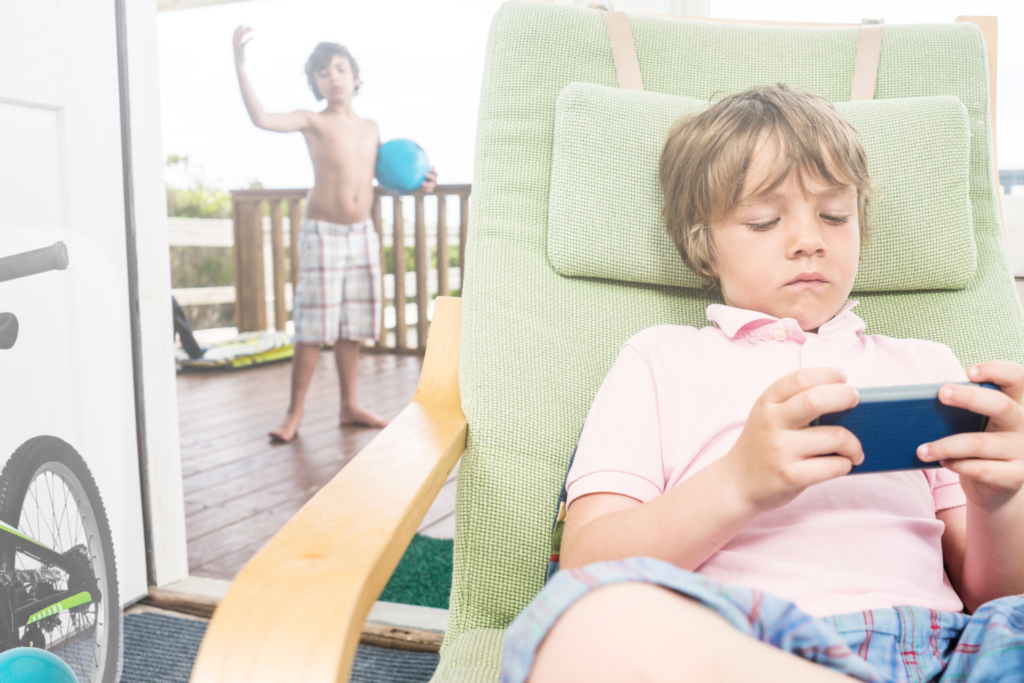Your tropical getaway in a glass! Dreaming of...
Read More

Why Screen-Free Time Matters (Especially in the Early Years)
We all know screens are part of modern life—and yes, they can be total lifesavers during dinner prep or long car rides (no shame in that!). But when it comes to brain development, especially in the early years, what kids aren’t doing matters just as much as what they are.
Here’s the wild part: a child’s brain doubles in size during the first year, and by age 3, it’s already 80% developed. By 5? It’s up to 90%. That means the early years are absolutely packed with potential—and every minute really does count.
Screen-free play isn’t just a nice idea; it’s fuel for developing brains. It supports:
Faster neural growth through movement, hands-on exploration, and real-world problem-solving
Stronger emotional regulation as kids process feelings through pretend play and physical activity
Better communication skills that come from face-to-face interactions, not just screen swipes
And as kids get older, balance becomes even more important. Too much screen time—especially in the preteen and teen years—has been linked to mood swings, sleep struggles, anxiety, and trouble connecting emotionally. While we can’t (and don’t need to) ban screens completely, building in regular screen-free play helps protect their mental and emotional health long-term.
Bottom line? Every screen-free moment is an investment in your child’s growth. And the good news is, with the right activities, they might not even miss the screens.
We all use screens as occasional digital babysitters (no judgment here!), but carving out time away from screens is more important than ever.
Here’s what your child gets from screen-free play:
Even short bursts of meaningful, screen-free play can lead to better focus, improved sleep, and more balanced behavior[1][7]. The trick? Make these activities fun and engaging—so kids actually want to unplug!
💡PARENT TIP Even 30 minutes of screen-free play daily can make a noticeable difference in your child’s behavior and sleep quality. Start small and build from there!

Before we get to the actual activity ideas, let’s talk about how to set your home and routines up for success. Whether your child is 3 or 13, a few intentional shifts in your space—and in your habits—can make unplugged fun more appealing.
If the only things easily accessible are remotes and tablets, that’s what kids will reach for. Try creating small “play zones” throughout your home that naturally draw your child’s interest:
When screen-free materials are visible and enticing, kids are more likely to choose them over devices.
If screens have become the default entertainment, consider a brief “screen fast” to reset everyone’s expectations. A weekend of intentional screen-free time can break the digital dependency cycle and open kids up to alternatives.
Little eyes are always watching. If you’re saying “no screens” while scrolling Instagram, the mixed message makes it harder to set limits. Try establishing screen times for yourself, too—like keeping phones off during meals or playtime.
Forget perfect. Kids don’t need a curated experience—they need you. Even just 10–15 minutes of fully present, imperfect play each day has a huge impact on their development (and your relationship!).
✨5 Quick and Easy Ways to Support Screen-Free Play

These screen-free play ideas channel physical energy in positive ways:
Transform your living room into a challenge course using pillows, furniture, and masking tape lines. Time their runs and watch them try to beat their records! You can adjust difficulty based on age and ability. Boosts physical coordination and problem-solving[6][7].
Crank up favorite songs and dance wildly, freezing when music stops. For extra giggles, freeze in silly positions or specific shapes you call out. This simple activity tops many parents’ lists of go-to screen-free play ideas because it requires zero prep. Encourages movement and self-regulation[7].
Write different animals on paper scraps and put them in a bowl. Kids draw one and must move like that animal until the next turn. These ideas tap into children’s natural love of pretend and physical comedy. Supports imaginative play and gross motor skills[10].
Keep a balloon from touching the ground, play balloon volleyball, or create balloon tennis with paper plates taped to sticks. The slow-motion movement of balloons makes this accessible even for younger children. Develops hand-eye coordination and teamwork[7].
Fill containers with rice, beans, water beads, or sand, then add measuring cups, funnels, and small toys. These activities engage multiple senses and can keep kids absorbed for surprising lengths of time. Engages multiple senses, supporting cognitive and emotional development[3][7].
🌟Quick tip: Keep a few of these in your back pocket for those “I’m bored” moments—most need zero prep and burn off extra energy fast.

Collect smooth rocks and draw simple pictures on them with permanent markers. Kids draw random stones and create stories connecting the images. This builds narrative skills that support reading comprehension. Enhances narrative skills and creativity[3][10].
Never throw away good boxes! With masking tape and safety scissors, kids can transform cardboard into cars, rocket ships, doll houses, or robot costumes. Open-ended screen-free play ideas like this expand engineering thinking. Fosters engineering thinking and fine motor skills[10].
Collect leaves, sticks, and flowers during a walk, then create collages or mandalas. These ideas connect children to the natural world while developing fine motor skills and pattern recognition. Connects children to the environment and supports sensory development[8].
Make homemade play dough together (1 cup flour, 1/2 cup salt, 2 tsp cream of tartar, 1 cup water, 1 tbsp oil, food coloring), then create mini-worlds, practice letters, or make pretend food. Tactile play engages different sensory pathways than screen time. Encourages tactile exploration and imaginative play[10].
Hang a white sheet and place a lamp behind it. Use hands, puppets, or cut-out characters to create shadow plays. These theatrical play ideas encourage storytelling and performance skills. Builds storytelling and performance abilities[10].
✂️Creative Corner: Keep a “creation station” stocked with recyclables, tape, scissors, and markers. The best creative activities often come from “junk” that would otherwise be thrown away! Set a weekly creative challenge to keep enthusiasm high.

Great for kids who ask “why?” about everything:
Simple experiments like baking soda and vinegar reactions, cornstarch and water “oobleck,” or rainbow milk (milk, food coloring, and dish soap) introduce scientific concepts. This makes learning tangible. Introduces scientific concepts through hands-on learning[10].
Create bingo cards with items to find outdoors: something rough, something that makes noise, five different leaves, etc. Exploration sharpens observation skills. Sharpens observation and critical thinking[6][8].
Spread peanut butter on pine cones or toilet paper tubes, roll in bird seed, and hang outside where you can watch feathered visitors. This connects children to their environment while teaching patience and observation. Teaches patience and environmental awareness[8].
Plant quick-growing seeds like beans in clear cups to observe root development, or create a mini herb garden in a sunny window. These lifetime skills teach cause and effect along with responsibility and understanding of natural processes[8].
Fill the sink or a bin with water and gather various household objects. Have kids predict whether each will sink or float, then test their hypotheses. These simple ideas introduces the scientific method in a tangible way[10].
📝Discovery zone: Keep a “wonder journal” nearby so kids can write down or draw their observations and questions.

Set up a tent or make a blanket fort, complete with flashlights, books, and stuffed animal “wildlife.” These immersive activities create novel experiences without leaving home. An extra bonus to indoor camping is that they stimulate imagination and family bonding[10,13].
Place a household object in an opaque bag. Kids feel it without looking, then try to draw what they think it is. This is a fun and easy way to develop tactile discrimination, drawing skills and encourages creativity[10,5].
Create an instant small-world play scene with masking tape roads on carpet or floor. Add blocks for buildings and toy cars for endless imaginative play. These screen-free play ideas can be expanded over days by adding new elements. Promotes imaginative play and spatial reasoning[5,10,13].
Hide small objects or written clues around the house for kids to find in sequence, leading to a final “treasure.” These are great ways to build memory and deductive reasoning [5,13].
Create personalized board games using cardboard, markers, and small toys as playing pieces. Even simple path games with challenges written on spaces become fun games when children help design them. Plus, it encourages higher-level thinking, problem solving, rule-making and develop strategy skills[10,13].
🌧️Rainy day win: Create a special box of “bad weather” toys and crafts they only see on those cabin-fever days.

Let’s be honest – sometimes kids push back against putting down their electronics, especially if they’re used to digital entertainment. That’s why we’ve developed a quick toolkit of ideas to show you how to navigate the transition:
Replace just one regular screen session with a screen-free activity rather than attempting a complete digital detox. Small wins build momentum.
Many screen conflicts stem from unclear expectations. Using visual timers for both screen time and screen-free time helps children see boundaries and reduces arguments. Create a visual schedule or give a 5-minute heads-up that screentime is ending using a timer. Create a habit of making the transitions expected and appealing.
Develop consistent routines for moving between screens and screen-free play:
Rather than emphasizing screen reduction, highlight the exciting screen-free activity and time you’re adding to family life. Positive framing reduces resistance.
💡Be Prepared for Resistance: keep high-interest activities ready when screens go off. Give 5-minute warnings before screen time ends. Always acknowledge feelings (“I know it’s hard to stop”) while maintaining boundaries. Remember that resistance often decreases after the first few screen-free sessions as children rediscover other pleasures.

🎉Celebrate Every Small Victory: The impact of your efforts may not be immediately obvious, but you’re building lifelong habits and skills. Your child’s ability to entertain themselves, connect with others, and think creatively are gifts that will serve them throughout life. You’ve got this!
Screen-free play time may need thoughtful modifications for special populations:
During illness, moves, new siblings, or other transitions, balance is key:
While screen-free play can significantly improve family dynamics, sometimes additional help is beneficial if:
In these cases, consulting with your pediatrician or a family therapist can provide additional strategies.
📢Keep in Mind: Every family’s journey with screens will look different, especially during challenging periods or for children with unique needs. Give yourself grace during difficult times, and remember that consistency matters more than perfection. Seek support when needed – you don’t have to navigate technology challenges alone.

Numerous studies and expert reviews support the benefits of screen-free play:
Creativity and Emotional Well-being: Open-ended, screen-free activities encourage creativity, problem-solving, and emotional regulation, all of which are diminished by excessive passive screen use[5][2][13].
🔬The science is clear: screen-free play is essential for healthy development across cognitive, social, physical, and emotional domains. Even short periods of quality screen-free time can have measurable benefits for children of all ages.

✅Remember: Progress, Not Perfection: The goal isn’t eliminating screens completely but creating a healthy balance where screens are tools rather than default entertainment. Every minute your child spends engaged in screen-free play and interaction is building crucial developmental skills and family connections.
By consistently offering appealing alternatives and participating wholeheartedly yourself, you’re helping your children develop the internal resources they need for a healthy relationship with technology throughout life. In our digital world, these screen-free play skills may be among the most important gifts you can give them.

[1] “Screen Time Guidelines for Children by Age.” American Academy of Pediatrics, www.aap.org/en/patient-care/media-and-children/screen-time-guidelines-for-children. Accessed 3 May 2025.
[2] “The Value of Play in Child Development.” Child Development Institute, www.childdevelopmentinfo.com/development/the-value-of-play-in-child-development. Accessed 3 May 2025.
[3] “The Importance of Screen-Free Activities for Children.” SMH, www.smh.com/blog/the-importance-of-screen-free-activities-for-children. Accessed 3 May 2025.
[4] “Screen Usage Linked to Differences in Brain Structure in Young Children.” Science Blog, Cincinnati Children’s, scienceblog.cincinnatichildrens.org/screen-usage-linked-to-differences-in-brain-structure-in-young-children. Accessed 3 May 2025.
[5] “Digital Detoxing for Families.” Warrenton Pediatrics, warrentonpediatrics.com/digital-detoxing-for-families. Accessed 3 May 2025.
[6] “Screen Time and Its Health Consequences in Children and Adolescents.” PMC, National Center for Biotechnology Information, pmc.ncbi.nlm.nih.gov/articles/PMC10605067. Accessed 3 May 2025.
[7] “Screen time and young children: Promoting health and development.” PMC, National Center for Biotechnology Information, pmc.ncbi.nlm.nih.gov/articles/PMC5823000. Accessed 3 May 2025.
[8] “Screen-Free Fun: Fostering Children’s Mental Well-Being.” Burke Extension, North Carolina State University, burke.ces.ncsu.edu/2024/05/screen-free-fun-fostering-childrens-mental-well-being. Accessed 3 May 2025.
[9] “The Effects of Screen Time on Children’s Sleep Patterns.” Journal of Pediatric Health, www.journalofpediatrichealth.org/articles/screen-time-sleep-patterns. Accessed 3 May 2025.
[10] “How Screen-Free Play Boosts Creativity and Child Development.” Inspire Children, inspirechildren.com/digital-detox-for-kids-why-less-screen-time-equals-more-creativity. Accessed 3 May 2025.
[11] “Too Much Screen Time Hurts Toddlers’ Social Skills, New Study Shows.” University of Alberta, www.ualberta.ca/en/folio/2019/06/too-much-screen-time-hurts-toddlers-social-skills-new-study-shows.html. Accessed 3 May 2025.
[12] “Early Childhood Brain Development and Screen Use.” Developmental Science, www.developmentalscience.com/research/early-childhood-brain-development-screen-use. Accessed 3 May 2025.
[13] “The Importance of Screen-Free Activities for Kids: Nurturing Creativity and Connection.” Unbuckle Me, unbuckleme.com/blogs/lifestyle/the-importance-of-screen-free-activities-for-kids-nurturing-creativity-and-connection. Accessed 3 May 2025.
Why Screen-Free Time Matters (Especially in the Early Years) We...
Read MoreNatural Stress Support for Women Complete Guide to Natural Stress...
Read MoreFor years, fat was labeled the enemy of good health....
Read MoreCinnamon isn’t just a fragrant spice that makes your kitchen...
Read MoreWhen it comes to optimizing men’s health, natural adaptogens like...
Read MoreFilter out the noise and nurture your inbox with health and wellness advice that’s inclusive and rooted in medical expertise.